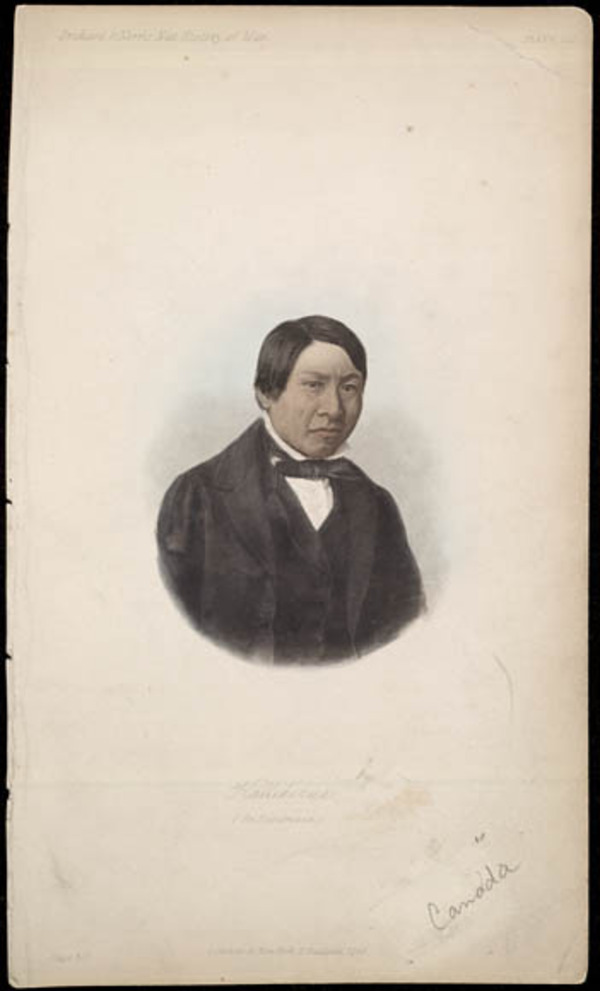KALLIHIRUA (modern spelling Qalasirssuaq, also known as Caloosà and Erasmus York, baptized Erasmus Augustine Kallihirua), Inuit guide; b. probably between 1832 and 1835 in the Thule region of northwest Greenland, son of Qissunguaq (Kirshung-oak) and Saattoq (Sa-too); d. unmarried 14 June 1856 in St John’s.
Kallihirua was encamped with a small group of Inuit at Cape York, Greenland, when Captain Erasmus Ommanney, commanding the Assistance and participating in Horatio Thomas Austin*’s expedition in search of Sir John Franklin*, called therein August 1850. He went on board the ship and consented to accompany the expedition as guide. The ship’s company gave him the name Erasmus York after their captain and the cape where he was taken aboard. One of his first tasks was to help check the veracity of a story reported by Adam Beck, an Inuk from southern Greenland who had been employed by Sir John Ross to act as interpreter aboard the Felix, another vessel engaged in the Franklin search that year. According to Beck, natives of the Cape York region had told him of the massacre of two ships’ crews, presumed to be Franklin’s, near Cape Dudley Digges in 1846. Kallihirua took the Assistance north, past the cape to Wolstenholme Fjord and showed Ommanney where another search vessel, the North Star, and its crew had passed the previous winter in the company of his own band. Some members of both groups had died of sickness but there was no sign of a massacre and no sign of Franklin. Kallihirua stayed with the Assistance for the remainder of the expedition, wintering on board near Griffith Island in Barrow Strait (N.W.T.). During the return voyage there was no opportunity to land him back at Cape York, so he went with the expedition to England, arriving in the autumn of 1851.
In November, at the suggestion of the Society for the Propagation of the Gospel and by direction of the Admiralty, he was placed in St Augustine’s College, a college for the education of missionary clergy of the Church of England, at Canterbury. There he was taught to read and write and was given religious instruction; for a year and a half he also spent five hours a day in the shop of a Canterbury tailor learning the trade. During 1852 and 1853 he helped Captain John Washington to revise his Eskimaux and English vocabulary, for the use of the Arctic expeditions (London, 1850). He was baptized Erasmus Augustine Kallihirua in St Martin’s Church near Canterbury on 27 Nov. 1853, in the presence of, among others, Eleanor Isabella Gell (Sir John Franklin’s daughter) and Captain Ommanney, who still maintained a fatherly interest in his welfare.
He left England in autumn 1855 for further religious training at Queen’s College (formerly the Theological Institute) in St John’s. Plans were made by the bishop of Newfoundland, Edward Feild*, for Kallihirua to accompany him on a trip to the coast of Labrador in the summer of 1856 where he was to begin missionary work among the Inuit. However, Kallihirua’s health, which had been poor since he had left the Arctic, suddenly became worse and he died at the college before he could leave St John’s.
Kallihirua was one of a small number of Inuit who, in the 19th century, won a degree of international fame through their association with polar expeditions. Even fewer had the experience of visiting the outside world; he was almost certainly the first of the Inuit of northern Greenland to do so. He appears to have adapted readily and cheerfully to his new life and to have won the affection and admiration of both Ommanney and his missionary colleagues, who had high hopes for his career before his premature death.
Cathedral of St John the Baptist (Anglican) (St John’s), Reg. of burials, 17 June 1856 (mfm. at PANL). G.B., Parl., Command paper, 1852, 50, [no.1436]: 269–670, Additional papers relative to the Arctic expedition . . . , 603–4; House of Commons paper, 1851, 33, no.97: 195–307, Arctic expeditions, return to an address of the Honourable the House of Commons, dated 7 February 1851; – for, copy or extracts from any correspondence or proceedings of the Board of Admiralty in relation to the Arctic expeditions . . . , 297–301. W. P. Snow, Voyage of the “Prince Albert” in search of Sir John Franklin: a narrative of every-day life in the Arctic seas (London, 1851). Times and General Commercial Gazette (St John’s), 18 June 1856. T. B. Murray, Kalli, the Esquimaux Christian; a memoir (new ed., London, [1857]). Aage Bugge, “Kallihirua, polareskimoen i Canterbury” and “Polareskimoen i Canterbury: supplerende oplysninger vedr. Kallihirua” in Grpnland (Charlottenlund, Denmark), 1965: 161–75 and 1966: 17–22.
Cite This Article
Clive Holland, “KALLIHIRUA (Qalasirssuaq), baptized Erasmus Augustine Kallihirua (Caloosà, Erasmus York),” in Dictionary of Canadian Biography, vol. 8, University of Toronto/Université Laval, 2003–, accessed December 31, 2025, https://www.biographi.ca/en/bio/kallihirua_8E.html.
The citation above shows the format for footnotes and endnotes according to the Chicago manual of style (16th edition). Information to be used in other citation formats:
| Permalink: | https://www.biographi.ca/en/bio/kallihirua_8E.html |
| Author of Article: | Clive Holland |
| Title of Article: | KALLIHIRUA (Qalasirssuaq), baptized Erasmus Augustine Kallihirua (Caloosà, Erasmus York) |
| Publication Name: | Dictionary of Canadian Biography, vol. 8 |
| Publisher: | University of Toronto/Université Laval |
| Year of publication: | 1985 |
| Year of revision: | 1985 |
| Access Date: | December 31, 2025 |




